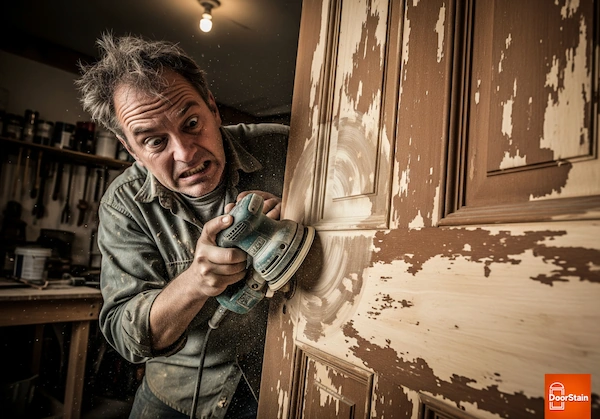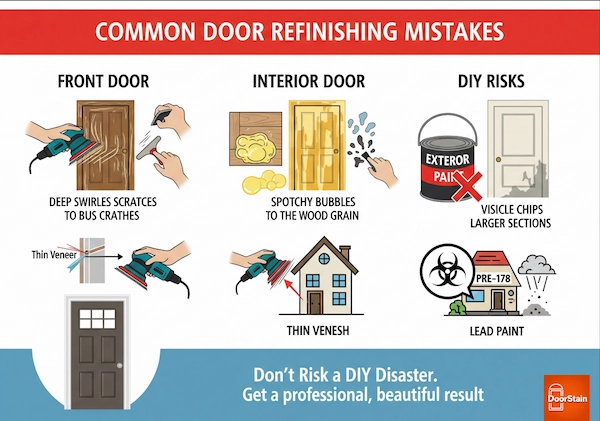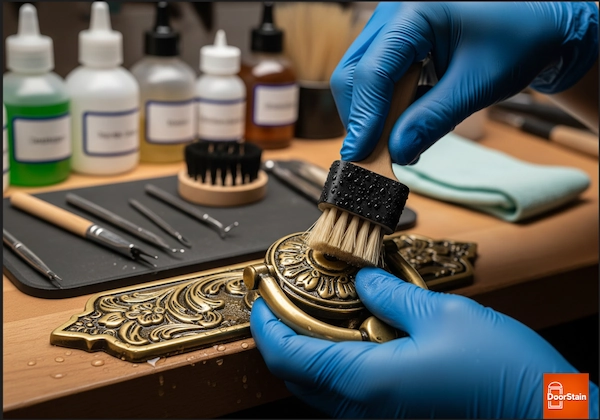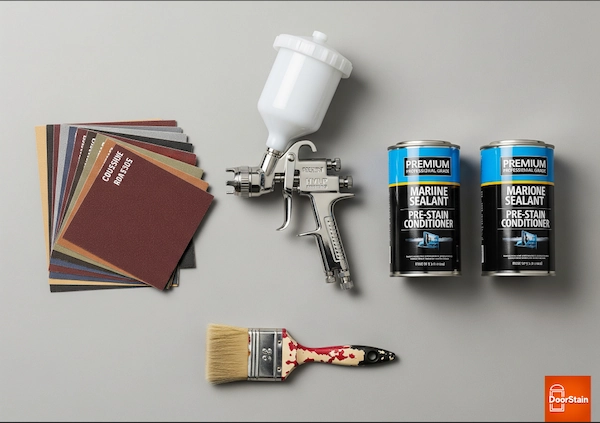A beautifully refinished door is a hallmark of a well-cared-for California home, enhancing curb appeal and providing a vital protective barrier against the elements. However, the path to achieving that flawless, durable finish is fraught with potential missteps. From the intense UV rays of Southern California to the coastal humidity, a door refinishing project can quickly turn from a rewarding upgrade into a costly, frustrating ordeal. Understanding and avoiding these common errors is the key to protecting your investment and achieving a result that lasts.
This guide delves into the most frequent door refinishing mistakes and provides expert advice on how to prevent them. We’ll cover everything from preparation and sanding to product selection and application, ensuring you have the knowledge to succeed. Whether you’re tackling a DIY project or seeking professional help, this information is crucial for any California homeowner. For a closer look at our specialized door refinishing services, we invite you to explore our main page.
Why Door Refinishing Mistakes Happen
Door refinishing mistakes almost always stem from a few core issues: haste, a lack of specialized knowledge, and an underestimation of the process’s complexity. Many homeowners see it as a simple paint job, but it’s a multi-step restoration that demands precision. Skipping a crucial step like cleaning or using the wrong sandpaper grit might save an hour upfront, but it can lead to weeks of frustration and a finish that peels within months.

Lack of Experience in Door Refinishing Services
Without hands-on experience, it’s easy to misidentify a door’s material (like thin veneer vs. solid wood), choose a product incompatible with the California climate, or fail to diagnose underlying moisture issues. A professional has seen hundreds of doors and understands how different materials and environments interact. This experience allows them to anticipate problems and apply proven techniques that a novice would only learn through trial and error—often at the expense of their own door.
Common Internal Door Refinishing Mistakes
While not exposed to harsh weather, internal door refinishing mistakes are common. These often involve applying the wrong type of paint (e.g., using exterior paint that has a strong odor and doesn’t cure properly indoors), failing to remove hardware leading to messy paint lines, or inadequate surface prep on slick, molded doors, causing the paint to chip and peel easily. These interior door refinishing mistakes can make an entire room look sloppy and unfinished.
The Risks of DIY Door Refinishing
The primary risk of a DIY approach is irreversible damage. Aggressively sanding a veneered door can strip it away completely, ruining the door. Using the wrong chemical stripper can damage the wood fibers. For homes built before 1978, there’s a significant risk of lead paint exposure without proper certification and safety protocols. These exterior door refinishing mistakes not only look bad but can also compromise the door’s structural integrity and your family’s health.
Don’t let a simple door refinishing mistake ruin your curb appeal. Our California-based specialists tackle interior, exterior, and front door refinishing mistakes daily, and guarantee professional, beautiful results. Book your onsite assessment now!

Top Front Door Refinishing Mistakes & How to Avoid Them
Your front door is the focal point of your home’s exterior, making front door refinishing mistakes particularly noticeable and damaging to your curb appeal. The process of refinishing a door correctly is critical.
Front Door Sanding Errors
Sanding is where many DIY projects go wrong. The goal is to create a smooth, uniform surface for the new finish to adhere to, not to gouge the wood. Common errors include:
-
Using the Wrong Grit: Starting with sandpaper that is too coarse can leave deep, swirling scratches that are difficult to remove. Starting too fine won’t effectively remove the old, failed finish.
-
Sanding Against the Grain: This creates unsightly cross-grain scratches that become glaringly obvious once the stain is applied.
-
Uneven Pressure: Applying too much pressure with a power sander can create divots or “wavy” spots in the wood.
-
Destroying Veneer: Many modern doors have a very thin wood veneer. Treating it like solid wood and over-sanding is the fastest way to permanently damage it.
Fails in Front Door Staining and Sealing
After sanding, the application of stain and sealant is the final hurdle. A splotchy, uneven stain is often caused by inconsistent absorption, especially in softwoods like pine. This is prevented by using a pre-stain wood conditioner. Streaks occur when excess stain isn’t wiped off properly and evenly. The biggest failure in entry door refinishing, however, is choosing a cheap, inadequate sealant that offers no UV protection, dooming the door to fade and peel within a year.
If you’ve already experienced a refinishing disaster, our door repair and refinishing services can restore your entryway fast.
Weather-Related Front Door Refinishing Mistakes
California’s climate is a major factor. Applying stain or varnish in direct, hot sun can cause it to dry too quickly, resulting in bubbles and brush marks. High humidity can prevent the finish from curing properly, leaving it soft and sticky. This applies to a garage door refinish as well, where the large surface area is highly susceptible to temperature fluctuations during application. Ignoring the weather forecast is a recipe for failure.

Most Common Interior Door Refinishing Mistakes
Interior doors may not face the sun and rain, but they have their own set of challenges. Success depends on avoiding common errors in preparation and product choice.
Ignoring Proper Cleaning Methods
You cannot paint over dirt, grease, or grime and expect a good result. Any surface contaminant will prevent the primer and paint from bonding correctly. It’s essential to thoroughly clean the door with an appropriate degreaser or TSP solution, paying special attention to the areas around doorknobs where oils from hands accumulate. Forgetting to remove and clean refinishing door hardware separately is another common oversight that leads to a messy, unprofessional job.
Poor Product Selection for Interior Doors
Not all paints are created equal. Using a low-quality, all-in-one paint-and-primer product on a slick, non-porous molded door will likely result in peeling. Wood doors require a good quality primer to seal the grain and ensure an even topcoat, while metal doors need a specific metal primer to prevent rust and ensure adhesion. A door refinishing DIY project often fails simply because the wrong products were chosen for the job.
Exterior Door Refinishing Mistakes and Professional Prevention
Exterior doors are a home’s first line of defense. When refinishing an old door, especially a vintage one, the stakes are high. Professional wood door refinishers prevent mistakes by using superior products and techniques.
Skipping Protective Topcoats
The single most critical mistake in an old door restoration is failing to apply a high-quality, UV-blocking topcoat. In California, the sun will break down a standard polyurethane finish in less than two years. A professional will use a marine-grade spar varnish or a specialized exterior polyurethane with UV absorbers to provide maximum protection, reapplying it as part of a maintenance plan.
Misjudging Humidity and Sun Exposure
A professional understands microclimates. A door facing south in direct sun requires a different level of protection than a door on a shaded porch. They will assess the specific conditions of your home and select products with the right flexibility and durability to withstand expansion and contraction caused by temperature and humidity swings. This level of analysis is crucial for any vintage door repair or restoration to ensure longevity.

Mistakes in Garage Door and Metal Door Restoration
Garage doors and metal doors present unique challenges that are often mishandled in DIY projects.
Garage Door Paint Prep Fails
The sheer size of a garage door makes proper prep daunting. The most common failure is inadequate cleaning and sanding. Any chalky, oxidized paint must be completely removed, or the new paint will have nothing to bond to and will peel off in sheets. Professional wood door refinishing services that also handle garage doors use power washers and sanders to ensure the surface is perfectly prepared for a durable finish.
Refinishing Metal Doors: What Can Go Wrong?
When refinishing metal doors, the biggest mistake is ignoring rust. Simply painting over a rust spot is like putting a bandage on a serious wound. The rust will continue to grow underneath the paint, eventually bubbling up and ruining the finish. A professional will grind away all rust, treat the area with a rust converter, and then apply a high-adhesion metal primer before painting. Another common error is failing to sand and restain door surfaces (or rather, sand and repaint for metal), which is essential for creating a “tooth” for the new paint to grip.
How Professional Door Refinishing Services at Cali Door Stain Prevent Mistakes
Hiring a top-tier front door refinishing service like Cali Door Stain is the surest way to avoid costly errors. Our process is built on a foundation of expertise, meticulous technique, and superior materials. We believe in the old adage, “The bitterness of poor quality remains long after the sweetness of low price is forgotten.”
Our Certified Techniques for Internal and Front Door Refinishing
Our certified team begins with a thorough assessment to correctly identify your door’s material and condition. We use professional-grade sanders with integrated dust extraction to ensure a clean workspace and a perfectly smooth surface. We apply pre-stain conditioners for an even, blotch-free finish and use only premium, marine-grade varnishes and UV-blocking sealants designed to withstand California’s demanding climate. Every step is executed with precision to guarantee a beautiful and long-lasting result.
Why Door Refinishing DIY Often Fails
DIY projects often fail due to a gap between ambition and execution. Homeowners may lack the specialized tools (like a high-volume, low-pressure sprayer for a factory-smooth finish), the time for meticulous multi-stage sanding, or the knowledge to select the right products. A small mistake, like not allowing proper cure time between coats, can compromise the entire project, leading to a finish that fails prematurely.
Our certified team ensures flawless results—saving you from costly errors and giving your doors lasting beauty. Don’t risk a DIY disaster: Get your free expert consultation today from DoorStain!
FAQs About Door Refinishing Mistakes & Services
Can door refinishing mistakes be fixed?
Most mistakes, like streaks, bubbles, or a splotchy stain, can be fixed, but it almost always involves sanding the finish back down and starting over. More serious errors, like sanding through a veneer or using a stain that’s too dark, are extremely difficult or impossible to fix without professional intervention.
Is it better to call a professional door refinishing company?
If you want a guaranteed, durable, and flawless finish, especially for a valuable front door, it is always better to hire a professional. The cost of hiring an expert is often less than the cost of fixing a failed DIY project and potentially replacing a ruined door.
What are the signs of a poorly refinished door?
Tell-tale signs include a streaky or uneven color, visible brush strokes or drips, a sticky or rough texture, peeling or bubbling paint, and swirl marks from a power sander. A high-quality finish should be perfectly smooth, even in color, and feel hard and durable to the touch.
